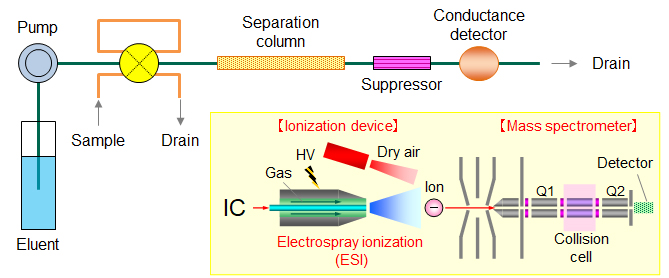- HOME
- Technical Information
- Commissioned Analysis and Research
- Ion Chromatography:IC
Ion Chromatography : IC
Principle
Ion chromatography is one of the most popular modes in liquid chromatography, using ion exchangers as stationary phase and eluent as mobile phase. In the chromatogram of the sample solution obtained by IC, the ionic species is assigned by the retention time of the peak and the concentration is determined by the peak area in comparison with the result of a standard solution. Conductance detector is commonly used in IC because high-sensitive analysis can be achieved by placing suppressor in front of the detector.
Ion chromatography mass spectrometry (IC/MS) is an analytical method in which a mass spectrometer as a detector is connected to IC. Selectivity can be improved dramatically compared with IC, since the mass spectrometer selects ionic species by differences in m/z. Our mass spectrometer consists of an electrospray ionization (ESI) device and triple quadrupole system, which may lead to estimation of chemical structure of unknown ionic species.

By means of IC and IC/MS, high sensitive analysis of inorganic anions such as chloride and sulfate, organic acids like formate, inorganic cations such as sodium and ammonium ions, amines like tetramethylammonium, can be achieved. Liquid sample except aqueous solutions, gaseous and solid samples need to be processed by applying appropriate pretreatment before measurement.